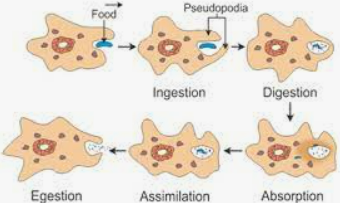- Home/
- CDS & Defence/
- Article
Describe the process of nutrition in amoeba with the help of diagram.
By BYJU'S Exam Prep
Updated on: September 25th, 2023
The process of nutrition in amoeba are ingestion, digestion, absorption, assimilation, and egestion. The amoeba lacks a specific organ for nourishment. Pseudopodia are used to spread the entire process across the surface of the body. A process known as phagocytosis provides nutrition to amoebas. The method through which the organism absorbs the food is called phagocytosis.
Process of Nutrition in Amoeba
Ingestion
- The act of ingesting involves bringing food into the body, either through swallowing or absorption.
- The amoeba extends its pseudopodia to surround the food and enclose it, creating a food vacuole.
Digestion
The food vacuoles are carried further into the cell in amoeba, where the digestive enzymes break down the huge, intractable particles into the smallest molecules.
Absorption
- In this phase of absorption, the nutrients from the digested food are taken up by the cell’s cytoplasm while the undigested food particles are left behind. Dispersion is the name of this procedure.
- Glycogen and lipids are the two forms in which extra food is stored.
Assimilation
- The process of extracting energy from the absorbed food molecules is known as assimilation.
- Amoeba uses the food molecules they have ingested to provide the energy needed for the cell’s various life functions.
Egestion
- Egestion is the process of removing unprocessed food from the body.
- This procedure is used by amoeba to expel undigested food from its body by rupturing the cell membrane.

Summary:
Describe the process of nutrition in amoeba with the help of a diagram.
Ingestion, digestion, absorption, assimilation, and egestion are all parts of the amoeba’s nutritional process. Holozoic nutrition is the term for the amoeba’s mode of nutrition. It entails the consumption of food material as well as its digestion and egestion.
